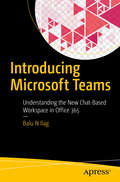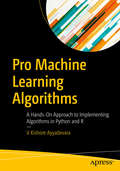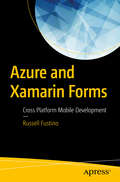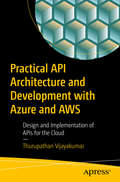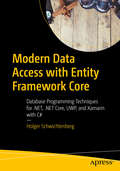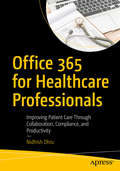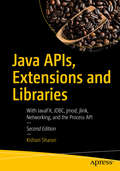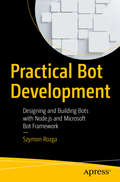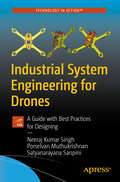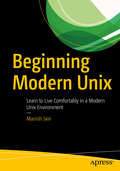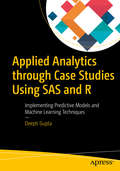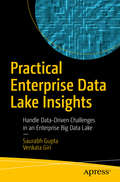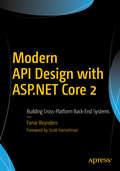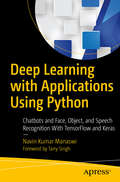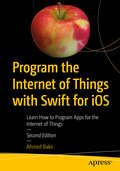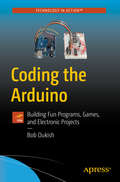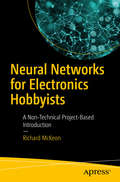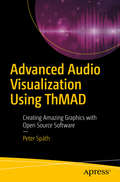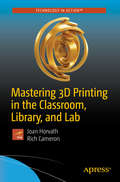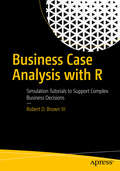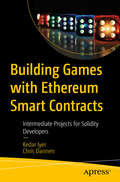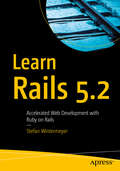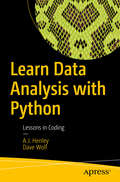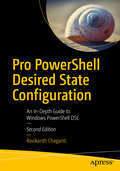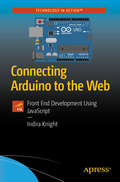- Table View
- List View
Introducing Microsoft Teams: Understanding the New Chat-Based Workspace in Office 365
by Balu N IlagGain industry best practices from planning to implementing Microsoft Teams and learn how to enable, configure, and integrate user provisioning, management, and monitoring. This book also covers troubleshooting Teams with step-by-step instructions and examples. Introducing Microsoft Teams gives you the comprehensive coverage you need to creatively utilize Microsoft Teams services.The author starts by giving an introduction to Microsoft Teams and its architecture followed by optimizing the Teams experience where he describes how organizations can prepare for Teams and enhance existing services. He further shows you how to manage and control the Microsoft Teams experience along with its capabilities and enhancements. You’ll learn how to migrate from Skype for Business to Microsoft Teams with a step-by-step tutorial. Finally, you’ll get to grips with Teams troubleshooting and best practices.This book has detailed coverage that helps you exploit every capability Microsoft Teams has to offer. It provides the answers you need and the insight that will make your journey from Skype for Business to Teams easier. What You Will Learn Enable guest access in Teams Provision and manage users in Teams Administrate Teams and channelsOptimize the Teams experienceEnable and configure Microsoft TeamsPrepare your network for Microsoft Teams and Office 365 services Migrate from Skype for Business to Microsoft TeamsWho This Book Is ForUnified communication administrators and IT support engineers who are currently supporting an existing unified communication platform such as Skype for Business (Lync). It would also help support engineers, new administrators, and consultant to start their journey with Teams.
Pro Machine Learning Algorithms: A Hands-On Approach to Implementing Algorithms in Python and R
by V Kishore AyyadevaraBridge the gap between a high-level understanding of how an algorithm works and knowing the nuts and bolts to tune your models better. This book will give you the confidence and skills when developing all the major machine learning models. In Pro Machine Learning Algorithms, you will first develop the algorithm in Excel so that you get a practical understanding of all the levers that can be tuned in a model, before implementing the models in Python/R.You will cover all the major algorithms: supervised and unsupervised learning, which include linear/logistic regression; k-means clustering; PCA; recommender system; decision tree; random forest; GBM; and neural networks. You will also be exposed to the latest in deep learning through CNNs, RNNs, and word2vec for text mining. You will be learning not only the algorithms, but also the concepts of feature engineering to maximize the performance of a model. You will see the theory along with case studies, such as sentiment classification, fraud detection, recommender systems, and image recognition, so that you get the best of both theory and practice for the vast majority of the machine learning algorithms used in industry. Along with learning the algorithms, you will also be exposed to running machine-learning models on all the major cloud service providers.You are expected to have minimal knowledge of statistics/software programming and by the end of this book you should be able to work on a machine learning project with confidence. What You Will LearnGet an in-depth understanding of all the major machine learning and deep learning algorithms Fully appreciate the pitfalls to avoid while building modelsImplement machine learning algorithms in the cloud Follow a hands-on approach through case studies for each algorithmGain the tricks of ensemble learning to build more accurate modelsDiscover the basics of programming in R/Python and the Keras framework for deep learningWho This Book Is ForBusiness analysts/ IT professionals who want to transition into data science roles. Data scientists who want to solidify their knowledge in machine learning.
Azure and Xamarin Forms: Cross Platform Mobile Development
by Russell FustinoDiscover how to create cross platform apps for Android, iOS and UWP using Azure services and C# with Xamarin Forms. This book illustrates how to utilize Azure cloud storage for serving up Azure SQL DB data through Azure App Services.The book starts by setting up Xamarin and introducing Xamarin Forms and then covers the Azure Portal from a developer’s perspective and goes on to demonstrate how to build an Azure Service using Quickstart. You'll also see how to add Azure support to Xamarin Forms application. You'll review in detail how to build a Xamarin Form with Azure Client and modify an existing app to become a Xamarin Forms Client for Azure with offline synchronization.You then move on to third-party controls that speed up development. By the end of the book, you will be able to use Azure and Xamarin together and master how to use Azure Mobile Quickstarts, Azure SQL plumbing, database synchronization and Xamarin Forms.What You'll LearnCreate a Xamarin Forms App and understand the Structure of a Xamarin Forms App. Navigate pages and use platform specific coding. Use images, ListView and the Azure Mobile App Quickstart to build a Service and Xamarin Forms appModify an existing app to use Azure Client Libraries, understand offline storage with SQLite and incorporate offline synchronizationWho This Book Is For Software developers new to Xamarin and/or Azure and for the developers who are familiar with both the technologies to use in mobile apps.
Practical API Architecture and Development with Azure and AWS: Design and Implementation of APIs for the Cloud
by Thurupathan VijayakumarLearn the business and technical importance of API design and architecture using the available cloud services from Azure and AWS.This book starts off with an introduction to APIs and the concept of API Economy from a business and organizational perspective. You'll decide on a sustainable API strategy and API architecture based on different case scenarios. You'll then look at actual examples on API development guidelines, providing a practical view and approach towards the API development and aligning teams in API development. This book walks you through the API gateway services available in Azure and AWS and reviews different approaches to API Security. This will prepare you for understanding the trade-off between security and the frictionless API experience. What You'll LearnImplement API Gateways to streamline API DevelopmentExamine Security Mapping with API gateways from Azure and AWSApply API implementation using Serverless architectureReview evolving APIs for monitoring and changing business requirementsUse code samples in API security implementations Who This Book Is ForDevelopers and architects with .NET and web development experience who want to learn about API design.
Modern Data Access with Entity Framework Core: Database Programming Techniques for .NET, .NET Core, UWP, and Xamarin with C#
by Holger SchwichtenbergC# developers, here’s your opportunity to learn the ins-and-outs of Entity Framework Core, Microsoft’s recently redesigned object-relational mapper. Benefit from hands-on learning that will teach you how to tackle frustrating database challenges, such as workarounds to missing features in Entity Framework Core, and learn how to optimize the performance of your applications, head-on!Modern Data Access with Entity Framework Core teaches best practices, guidance, and shortcuts that will significantly reduce the amount of resources you internally dedicate to programming data access code. The proven methods and tools taught in this book, such as how to get better performance, and the ability to select the platform of your choice, will save you valuable time and allow you to create seamless data access. Dive into succinct guidance that covers the gamut-- from installing Entity Framework Core, reverse engineering, forward engineering (including schema migrations), and data reading and modification with LINQ, Dynamic LINQ, SQL, Stored Procedures, and Table Valued Functions- to using third-party products such as LINQPad, Entity Developer, Entity Framework Profiler, EFPlus, and AutoMapper. You'll also appreciate excerpts of conceptual software architecture discussion around Entity Framework Core that might otherwise take years to learn.What You'll LearnUnderstand the core concepts of Entity Framework Core, as well process models for existing databases (reverse engineering) and the generation of database schemas from object models (forward engineering)Study real-world case studies for hands-on EF Core instructionGet up to speed with valuable database access scenarios and code samplesDiscover workarounds to augment missing features in Entity Framework CoreUse Entity Framework Core to write mobile appsBonus online appendix covers Entity Framework Core 2.1 release updatesWho This Book Is ForSoftware developers who have basic experience with .NET and C#, as well as some understanding of relational databases. Knowledge of predecessor technologies such as ADO.NET and the classic ADO.NET Entity Framework is not necessary to learn from this book.
Office 365 for Healthcare Professionals: Improving Patient Care Through Collaboration, Compliance, And Productivity
by Nidhish DhruLeverage Office 365 and the cloud in order to be more productive, secure, and compliant with healthcare standards. This book offers prescriptive guidance and real-world use cases to help you maximize and extend care for patients, while working with fewer resources and striving to stay modern and secure. Office 365 for Healthcare increases the value of your existing investment and infrastructure in Office 365 by teaching configurations and services that will resolve real day-to-day productivity and communication challenges. Understanding that each provider is unique, this book focuses on operational and clinical similarities that can be applied to any healthcare provider such as telehealth, readmission rate, shift scheduling, tumor board innovations, continuous education for medical practitioners, and more. What You'll Learn Configure Office 365 to enable a compliant and meaningful collaboration between care providers and patientsDiscover innovative uses through a tumor board collaborationUnderstand specific ways to improve nurse scheduling and trainingImprove telehealth for remote patientsApply simple techniques via the Office 365 tool setSecure Office 365 without affecting productivityIncrease operating efficiency and patient satisfaction by reducing lengths of stay and re-admission Who This Book is For IT pros, technical decision makers, and Office 365 users in the healthcare industry. Readers should have an understanding of Office 365, how healthcare organizations function, and an understanding of the technical challenges they are facing.
Java APIs, Extensions and Libraries: Swing, Javafx, Javascript, Jdbc And Network Programming Apis
by Kishori SharanThis book completes the Apress Java learning journey and is a comprehensive approach to learning Java APIs, extensions, and modules such as Java EE integration, mobile Java modules, JavaFX, and JDBC. In this book, you'll learn how to build user interfaces with Swing and JavaFX as well as how to write network programs with the new Java 9 and much more.Java APIs, Extensions and Libraries is for Java programmers who are familiar with the fundamentals of the Java language and Java programming, who are now ready to call upon the power of extended Java functionality available from the huge array of Java APIs, extensions, and libraries. After reading and learning from this book you'll be ready to become a professional Java programmer.What You’ll LearnExtend your Java skills beyond the fundamental object-oriented concepts and core language featuresApply Java Swing for building Java front ends Get started with Java network programmingConnect to databases and access data from Java programs using the JDBC APIWork with JavaFX, RMI (Remote Method Invocation), and JNI (Java Native Interface)Use the new scripting features of JavaWho This Book Is ForJava programmers who are familiar with the fundamentals of the Java language and Java programming.
Practical Bot Development: Designing And Building Bots With Node. Js And Microsoft Bot Builder Framework
by Szymon RozgaExplore the concept of bots and discover the motivation behind working with these new apps with messaging platforms. This book is an accessible resource teaching the basic concepts behind bot design and implementation. Each chapter builds on previous topics and, where appropriate, real working code is shown that implements the concepts. By just picking up a code editor, you can start creating smart, engaging, and useful bot experiences today.Practical Bot Development will teach you how to create your own bots on platforms like Facebook Messenger and Slack, incorporate extension APIs, and apply AI and ML algorithms in the cloud. By the end of this book, you'll be equipped with the information to reach thousands of new users with the bots you create!The book is a great resource for those looking to harness the benefits of building their own bots and leveraging the platform feasibility of them.What You’ll LearnUnderstand the general architecture of a botDistinguish between a great bot experience versus a bad bot experience.Explore the ideas behind natural language processing and apply them to bot developmentImplement real Messenger, Slack, and custom channel bots using Node.js and the Microsoft Bot Builder frameworkDeploy bots to Facebook Messenger and Slack Who This Book Is ForEngineers, hobbyists, and the design oriented community looking looking for an introduction to the technologies and concepts involved in building bots. The experience level could be from beginner to expert, although some familiarity with Node.js and APIs will be assumed.
Industrial System Engineering for Drones: A Guide with Best Practices for Designing
by Neeraj Kumar Singh Porselvan Muthukrishnan Satyanarayana SanpiniExplore a complex mechanical system where electronics and mechanical engineers work together as a cross-functional team. Using a working example, this book is a practical “how to” guide to designing a drone system.As system design becomes more and more complicated, systematic, and organized, there is an increasingly large gap in how system design happens in the industry versus what is taught in academia. While the system design basics and fundamentals mostly remain the same, the process, flow, considerations, and tools applied in industry are far different than that in academia. Designing Drone Systems takes you through the entire flow from system conception to design to production, bridging the knowledge gap between academia and the industry as you build your own drone systems.What You’ll LearnGain a high level understanding of drone systemsDesign a drone systems and elaborating the various aspects and considerations of designReview the principles of the industrial system design process/flow, and the guidelines for drone systemsLook at the challenges, limitations, best practices, and patterns of system designWho This Book Is ForPrimarily for beginning or aspiring system design experts, recent graduates, and system design engineers. Teachers, trainers, and system design mentors can also benefit from this content.
Beginning Modern Unix: Learn to Live Comfortably in a Modern Unix Environment
by Manish JainDiscover how to leverage modern Unix even if you’ve never worked with Unix before. This book presents everything in conceptual terms that you can understand, rather than tips to be committed raw to memory. You will learn everyday tasks ranging from basic system administration—partitioning and mounting filesystems, software installation, network configuration, working from the command line) — to Bourne shell scripting, using graphical applications, as well as fanciful things such as emulation layers for Windows and Linux and virtualization with VirtualBox. It’s now 50 years since the creation of Unix but it is still growing. As Unix now moves to everyone's OS (open-source FreeBSD/Linux), it is the perfect time to start your journey with Beginning Modern Unix as your guide. What You'll Learn Live comfortably in a modern Unix environment, both on the command-line and in the graphical world. Choose the right hardware for UnixWork with Unix in real world settingsDevelop Unix applicationsReview advanced techniques in Shell scriptingWho This Book Is ForEveryone who uses a computer – those who intend to migrate to Unix as well as those who are worried about migrating to Unix, perhaps fearing it is a pure command-line or ‘difficult’ world.
Applied Analytics through Case Studies Using SAS and R: Implementing Predictive Models and Machine Learning Techniques
by Deepti GuptaExamine business problems and use a practical analytical approach to solve them by implementing predictive models and machine learning techniques using SAS and the R analytical language. This book is ideal for those who are well-versed in writing code and have a basic understanding of statistics, but have limited experience in implementing predictive models and machine learning techniques for analyzing real world data. The most challenging part of solving industrial business problems is the practical and hands-on knowledge of building and deploying advanced predictive models and machine learning algorithms. Applied Analytics through Case Studies Using SAS and R is your answer to solving these business problems by sharpening your analytical skills. What You'll Learn Understand analytics and basic data concepts Use an analytical approach to solve Industrial business problems Build predictive model with machine learning techniquesCreate and apply analytical strategiesWho This Book Is ForData scientists, developers, statisticians, engineers, and research students with a great theoretical understanding of data and statistics who would like to enhance their skills by getting practical exposure in data modeling.
Practical Enterprise Data Lake Insights: Handle Data-Driven Challenges in an Enterprise Big Data Lake
by Saurabh Gupta Venkata GiriUse this practical guide to successfully handle the challenges encountered when designing an enterprise data lake and learn industry best practices to resolve issues.When designing an enterprise data lake you often hit a roadblock when you must leave the comfort of the relational world and learn the nuances of handling non-relational data. Starting from sourcing data into the Hadoop ecosystem, you will go through stages that can bring up tough questions such as data processing, data querying, and security. Concepts such as change data capture and data streaming are covered. The book takes an end-to-end solution approach in a data lake environment that includes data security, high availability, data processing, data streaming, and more.Each chapter includes application of a concept, code snippets, and use case demonstrations to provide you with a practical approach. You will learn the concept, scope, application, and starting point.What You'll LearnGet to know data lake architecture and design principlesImplement data capture and streaming strategiesImplement data processing strategies in HadoopUnderstand the data lake security framework and availability modelWho This Book Is ForBig data architects and solution architects
Modern API Design with ASP.NET Core 2: Building Cross-platform Back-end Systems
by Fanie ReyndersUse ASP.NET Core 2 to create durable and cross-platform web APIs through a series of applied, practical scenarios. Examples in this book help you build APIs that are fast and scalable. You’ll progress from the basics of the framework through to solving the complex problems encountered in implementing secure RESTful services. The book is packed full of examples showing how Microsoft’s ground-up rewrite of ASP.NET Core 2 enables native cross-platform applications that are fast and modular, allowing your cloud-ready server applications to scale as your business grows. Major topics covered in the book include the fundamentals and core concepts of ASP.NET Core 2. You'll learn about building RESTful APIs with the MVC pattern using proven best practices and following the six principles of REST. Examples in the book help in learning to develop world-class web APIs and applications that can run on any platform, including Windows, Linux, and MacOS. You can even deploy to Microsoft Azure and automate your delivery by implementing Continuous Integration and Continuous Deployment pipelines.What You Will LearnIncorporate automated API tooling such as Swagger from the OpenAPI specificationStandardize query and response formats using Facebook’s GraphQL query languageImplement security by applying authentication and authorization using ASP.NET IdentityEnsure the safe storage of sensitive data using the data protection stackCreate unit and integration tests to guarantee code qualityWho This Book Is ForDevelopers who build server applications such as web sites and web APIs that need to run fast and cross platform; programmers who want to implement practical solutions for real-world problems; those who want in-depth knowledge of the latest bits of ASP.NET Core 2.0
Deep Learning with Applications Using Python: Chatbots And Face, Object, And Speech Recognition With Tensorflow And Keras
by Navin Kumar ManaswiExplore deep learning applications, such as computer vision, speech recognition, and chatbots, using frameworks such as TensorFlow and Keras. This book helps you to ramp up your practical know-how in a short period of time and focuses you on the domain, models, and algorithms required for deep learning applications. Deep Learning with Applications Using Python covers topics such as chatbots, natural language processing, and face and object recognition. The goal is to equip you with the concepts, techniques, and algorithm implementations needed to create programs capable of performing deep learning.This book covers convolutional neural networks, recurrent neural networks, and multilayer perceptrons. It also discusses popular APIs such as IBM Watson, Microsoft Azure, and scikit-learn. What You Will Learn Work with various deep learning frameworks such as TensorFlow, Keras, and scikit-learn.Use face recognition and face detection capabilitiesCreate speech-to-text and text-to-speech functionalityEngage with chatbots using deep learningWho This Book Is ForData scientists and developers who want to adapt and build deep learning applications.
Program the Internet of Things with Swift for iOS: Learn How to Program Apps for the Internet of Things
by Ahmed BakirLearn how to build apps using Apple’s native APIs for the Internet of Things, including the Apple Watch, HomeKit, and Apple Pay. You'll also see how to interface with popular third-party hardware such as the Raspberry Pi, Arduino, and the FitBit family of devices.Program the Internet of Things with Swift and iOS is an update to the previous version and includes all new Swift 4 code. This book is a detailed tutorial that provides a detailed "how" and "why" for each topic, explaining Apple-specific design patterns as they come up and pulling lessons from other popular apps. To help you getting up and running quickly, each chapter is framed within a working project, allowing you to use the sample code directly in your apps.The Internet of Things is not limited to Apple devices alone, so this book also explains how to interface with popular third-party hardware devices, such as the Fitbit and Raspberry Pi, and generic interfaces, like Restful API’s and HTTPS. You'll also review new API's like Face ID and new design considerations, and look more closely at SSL and how to make IoT connected apps more resistant to hackers. The coverage of Apple Watch has been expanded as well. The Internet of Things is waiting — be a part of it!What You'll LearnUse Apple's native IoT Frameworks, such as HealthKit, HomeKit, and FaceIDInteract with popular third-party hardware, such as the Raspberry Pi, Arduino, and FitBitWork with real projects to develop skills based in experienceMake a smarter IoT with SiriKit and CoreMLWho This Book Is For The primary audience for this book are readers who have a grasp of the basics of iOS development and are looking to improve their Internet of Things-specific skills. Intermediate to Advanced level. The secondary audience would be business decision makers (managers, business analysts, executives) who are looking to gain a rough understanding of what is involved in Internet of Things development for iOS.
Coding the Arduino: Building Fun Programs, Games, and Electronic Projects
by Bob DukishGet started with Arduino and computer coding. This book is intended for those new to the Arduino and computer coding. and looking to gain the skills to write microcontroller programs that can act on given inputs and operate electromechanical output devices. Coding the Arduino contains four sections: background information, game development, electronic games and projects, and expanded programs. The final chapters expand on the functionality of some of the programs presented in previous chapters, and challenges you with capstone projects. The projects will be described where the program code that is presented can be modified, or in which two or more of the sample programs may be used to synthesize a new program as the solution to the problem that is presented. Additionally, review questions are presented at the end of each chapter to test your comprehension of the material. What You'll LearnUnderstand basic principles of technology, and about analog and digital electronics.Create games from scratch, where you interactively play against the program.Gain an introduction to Artificial Intelligence (AI)Who This Book Is ForElectronic hobbyists, makers of all levels, and teens with an interest in technology and coding who are looking to get started with Arduinos.
Neural Networks for Electronics Hobbyists: A Non-technical Project-based Introduction
by Richard McKeonLearn how to implement and build a neural network with this non-technical, project-based book as your guide. As you work through the chapters, you'll build an electronics project, providing a hands-on experience in training a network. There are no prerequisites here and you won't see a single line of computer code in this book. Instead, it takes a hardware approach using very simple electronic components. You'll start off with an interesting non-technical introduction to neural networks, and then construct an electronics project. The project isn't complicated, but it illustrates how back propagation can be used to adjust connection strengths or "weights" and train a network. By the end of this book, you'll be able to take what you've learned and apply it to your own projects. If you like to tinker around with components and build circuits on a breadboard, Neural Networks for Electronics Hobbyists is the book for you. What You'll LearnGain a practical introduction to neural networksReview techniques for training networks with electrical hardware and supervised learningUnderstand how parallel processing differs from standard sequential programmingWho This Book Is ForAnyone interest in neural networks, from electronic hobbyists looking for an interesting project to build, to a layperson with no experience. Programmers familiar with neural networks but have only implemented them using computer code will also benefit from this book.
Advanced Audio Visualization Using ThMAD: Creating Amazing Graphics with Open Source Software
by Peter SpäthLearn advanced techniques and improve your audio visualization skills with Thinking Machine Audio Dreams (ThMAD). With this book, you can concentrate on advanced examples and usage patterns, including using shaders in a more profound way, and how to incorporate ThMAD into a tool chain using the professional sound server JACK.
Mastering 3D Printing in the Classroom, Library, and Lab
by Joan Horvath Rich CameronLearn how to manage and integrate the technology of 3D printers in the classroom, library, and lab. With this book, the authors give practical, lessons-learned advice about the nuts and bolts of what happens when you mix 3D printers, teachers, students, and the general public in environments ranging from K-12 and university classrooms to libraries, museums, and after-school community programs.Take your existing programs to the next level with Mastering 3D Printing in the Classroom, Library, and Lab. Organized in a way that is readable and easy to understand, this book is your guide to the many technology options available now in both software and hardware, as well as a compendium of practical use cases and a discussion of how to create experiences that will align with curriculum standards. You'll examine the whole range of working with a 3D printer, from purchase decision to curriculum design. Finally this book points you forward to the digital-fabrication future current students will face, discussing how key skills can be taught as cost-effectively as possible.What You’ll LearnDiscover what is really involved with using a 3D printer in a classroom, library, lab, or public spaceReview use cases of 3D printers designed to enhance student learning and to make practical parts, from elementary school through university research labLook at career-planning directions in the emerging digital fabrication arenaWork with updated tools, hardware, and software for 3D printingWho This Book Is ForEducators of all levels, both formal (classroom) and informal (after-school programs, libraries, museums).
Business Case Analysis with R: Simulation Tutorials To Support Complex Business Decisions
by Robert D. Brown IIIThis tutorial teaches you how to use the statistical programming language R to develop a business case simulation and analysis. It presents a methodology for conducting business case analysis that minimizes decision delay by focusing stakeholders on what matters most and suggests pathways for minimizing the risk in strategic and capital allocation decisions. Business case analysis, often conducted in spreadsheets, exposes decision makers to additional risks that arise just from the use of the spreadsheet environment. R has become one of the most widely used tools for reproducible quantitative analysis, and analysts fluent in this language are in high demand. The R language, traditionally used for statistical analysis, provides a more explicit, flexible, and extensible environment than spreadsheets for conducting business case analysis. The main tutorial follows the case in which a chemical manufacturing company considers constructing a chemical reactor and production facility to bring a new compound to market. There are numerous uncertainties and risks involved, including the possibility that a competitor brings a similar product online. The company must determine the value of making the decision to move forward and where they might prioritize their attention to make a more informed and robust decision. While the example used is a chemical company, the analysis structure it presents can be applied to just about any business decision, from IT projects to new product development to commercial real estate. The supporting tutorials include the perspective of the founder of a professional service firm who wants to grow his business and a member of a strategic planning group in a biomedical device company who wants to know how much to budget in order to refine the quality of information about critical uncertainties that might affect the value of a chosen product development pathway. What You’ll LearnSet up a business case abstraction in an influence diagram to communicate the essence of the problem to other stakeholdersModel the inherent uncertainties in the problem with Monte Carlo simulation using the R languageCommunicate the results graphicallyDraw appropriate insights from the resultsDevelop creative decision strategies for thorough opportunity cost analysisCalculate the value of information on critical uncertainties between competing decision strategies to set the budget for deeper data analysisConstruct appropriate information to satisfy the parameters for the Monte Carlo simulation when little or no empirical data are available Who This Book Is For Financial analysts, data practitioners, and risk/business professionals; also appropriate for graduate level finance, business, or data science students
Building Games with Ethereum Smart Contracts: Intermediate Projects For Solidity Developers
by Chris Dannen Kedar IyerLearn how to take your existing knowledge of Ethereum and Solidity to the next level. Hone your development skills and become more familiar with the syntax of the Solidity language by working through well-tested, well-documented intermediate-level sample projects.You will begin by covering the basics of Ethereum, Solidity, and gaming theory. From there, you will move onto sample projects that use smart contract engineering to create fun casino-style games that you can deploy and test on your friends and colleagues with real ether. All games are provably fair and auditable, so that players know the house won’t always win!Ideal for any reader with exposure to Ethereum, the techniques this book teaches are applicable to game developers, software engineers, web developers, and cryptocurrency enthusiasts.What You'll LearnUse various features and best practices for smart contract programming in Ethereum and SolidityDevelop and deploy games of chance, similar to the kind you’d find in a casinoCreate fun, easy projects with Ethereumlntegrate the Ethereum blockchain into gamesWho This Book Is ForEntry-level programmers with some exposure to Ethereum; game developers, Blockchain and cryptocurrency enthusiasts looking to add Ethereum and Solidity development to their skill set; software engineers and Web developers
Learn Rails 5.2: Accelerated Web Development With Ruby On Rails (Learn Rails 5. 1 Ser.)
by Stefan WintermeyerLearn to build Rails-based web applications using all the latest features offered in Rails 5.2. Author Stefan Wintermeyer begins by teaching the basics of Ruby 2.5 before proceeding through all aspects of Rails, utilizing clean, succinct examples – rather than a single large application. This book covers topics including Active Storage, Credentials, Active Record, Scaffolding, REST, Routing, Bundler, Forms, Cookies, and Sessions, all of which are vital for modern Rails web applications. To complement these topics you’ll also learn about test-driven development, Action Cable, Active Job, Action Mailer, I18n, Asset Pipeline, and caching. Finally, you’ll see a how-to for a production web server with nginx. This complete set of skills will set you up for a future of efficient and elegant Rails coding.What You Will LearnUse the Ruby on Rails web development framework Install and manage the Rails frameworkPersist data for your web application with Active Record Work with forms Apply a test-driven development approach to your Rails-based web applicationsDiscover many Rails secrets and tips Who This Book Is ForBeginners with at least some prior programming experience. Ruby experience is helpful, but not required.
Learn Data Analysis with Python: Lessons In Coding
by A. J. Henley Dave WolfGet started using Python in data analysis with this compact practical guide. This book includes three exercises and a case study on getting data in and out of Python code in the right format. Learn Data Analysis with Python also helps you discover meaning in the data using analysis and shows you how to visualize it. Each lesson is, as much as possible, self-contained to allow you to dip in and out of the examples as your needs dictate. If you are already using Python for data analysis, you will find a number of things that you wish you knew how to do in Python. You can then take these techniques and apply them directly to your own projects.If you aren’t using Python for data analysis, this book takes you through the basics at the beginning to give you a solid foundation in the topic. As you work your way through the book you will have a better of idea of how to use Python for data analysis when you are finished.What You Will LearnGet data into and out of Python codePrepare the data and its formatFind the meaning of the dataVisualize the data using iPythonWho This Book Is For Those who want to learn data analysis using Python. Some experience with Python is recommended but not required, as is some prior experience with data analysis or data science.
Pro PowerShell Desired State Configuration: Using Windows Powershell Dsc And Dsc Core
by Ravikanth ChagantiUse Windows PowerShell Desired State Configuration (DSC) to configure your infrastructure on-premises and in the cloud. In an environment where changes and deployments are happening all the time, DSC makes the necessary adjustments to the system so you don’t have to. Pro PowerShell Desired State Configuration shows you how.PowerShell Desired State Configuration (DSC) is a powerful configuration management platform that makes it easier than ever to perform configuration management of your infrastructure, whether on-premises or in the cloud. With Pro PowerShell Desired State Configuration, Ravikanth Chaganti revises and significantly expands his previous edition, bringing you a complete in-depth reference for applying this evolving technology in your day-to-day work.What’s new in this edition?Get up-to-date, in-depth guidance on DSC in the data centerUnderstand the central role that DSC plays in DevOps todayIntegrate DSC into build and release management toolsLearn to think and act like a developer when automating your configuration management, creating a testable, robust process that you can use again and againFind out why and how DSC has an important role to play in public and private cloud deploymentsApply DSC in the cloud with Microsoft Azure or Amazon Web Services or Google Cloud PlatformWho This Book Is ForIT administrators, developers and DevOps engineers working in Windows-based data center environments. With a little prior PowerShell scripting experience, this book can be used as an in-depth reference to creating, customizing, and extending DSC in Windows. IT administrators with limited scripting experience will also find this book a useful overview of what DSC offers and how to use DSC resources to automate configuration management and deployment.
Connecting Arduino to the Web: Front End Development Using JavaScript
by Indira KnightCreate physical interfaces that interact with the Internet and web pages. With Arduino and JavaScript you can create interactive physical displays and connected devices that send data to or receive data from the web. You'll take advantage of the processes needed to set up electronic components, collect data, and create web pages able to interact with electronic components.Through exercises, projects, and explanations, this book will give you the core front end web development and electronics skills needed to create connected physical interfaces and build compelling visualizations with a range of JavaScript libraries.By the end of the book you will have developed fully working interactive prototypes capable of sending data to and receiving data from a physical interface. Most importantly, Connecting Arduino to the Web will give you a taste of what is possible and the knowledge to create your own connected physical interfaces and bring the web into your electronics projects.What You'll LearnBuild an Internet of Things dashboard that updates with electronics attached to an ArduinoUse components to interact with online 3D displaysCreate web pages with HTML and CSSSet up a Node.js serverUse WebSockets to process live dataInteract with scalable vector graphics (SVG)Who This Book Is ForTechnologists, developers, and enthusiasts looking to extend their skills, be able to develop physical prototypes with connected devices, and with an interest in getting started with IoT. Also, those excited by the possibilities of connecting the physical and the web.
